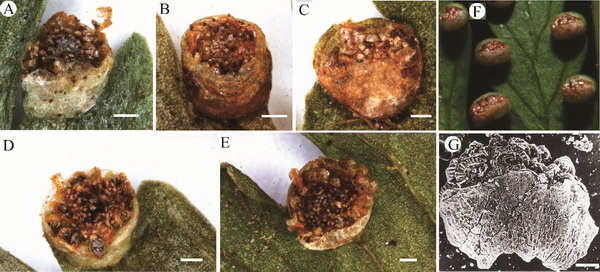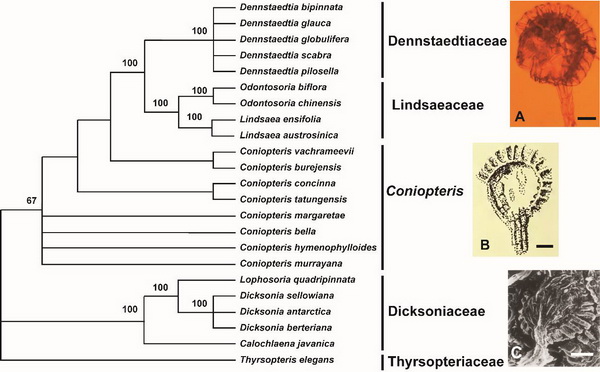It is generally recognized that the fossil records are incomplete in nature, yet fossils had very important impact on our development of evolutionary theory. The value of a particular fossil in contributing to our knowledge in evolutionary history for any lineage depends upon an adequate description of sufficient characters including synapomorphies, necessary for the accurate identification of its affinities or precise phylogenetic placement.
Here is a case of such kind of study. The extinct fern genus Coniopteris was a typical component in the Mesozoic flora with a wide distribution in both Northern and Southern Hemispheres from Early Jurassic to Early Cretaceous, and it played a very important role in stratigraphic correlation, while its character evolution and systematic position have both been unsolved mysteries.
Prof. LI Chunxiang from Nanjing Institute of Geology and Palaeontology of Chinese Academy of Sciences and her colleagues analyzed the combined data of morphology and molecular data available to re-evaluate the systematic position of Coniopteris.
The study produced the results as: (1) all extant genera in Dicksoniaceae have bivalvate indusia, while most species of Coniopteris have cup-shaped indusia; (2) most Dicksoniaceae occur in the tropical zone, different from the temperate habitats for most Coniopteris species; (3) Coniopteris may be herbaceous, whereas extant Dicksoniaceae are mostly tree-like ferns; and (4) Dicksoniaceae and Thyrsopteridaceae all have oblique annuli, while most species of Coniopteris have vertical ones.
Based on these differences, Coniopteris should not be treated in Dicksoniaceae. Its systematic position was further evaluated by a cladistic analysis using morphological characters of spore-producing organs and spores and integrated with studies of fern molecular phylogeny as a constraint (molecular backbone). The results show that Coniopteris is clustered with Dennstaedtia, Lindsaea, and Odontosoria, not with Calochlaena, Dicksonia, and Lophosoria in Dicksoniaceae.
The researchers therefore propose that Coniopteris may be more closely related with Polypodiales than with Dicksoniaceae, and Coniopteris is probably a stem group of Polypodiales. This interpretation is consistent with the vertical annuli of Coniopteris, an apparent synapomorphy of Polypodiales.
The research was supported by Project from Shanghai Landscaping & City Appearance Administrative Bureau (Grant No. G162422), Projects of State Key Laboratory of Palaeobiology and Stratigraphy (Nanjing Institute of geology and Palaeontology, CAS) (Grant No. Y626040108), and Strategic Priority Research Program of Chinese Academy of Sciences (Grant No. XDB26000000).

Sori of Coniopteris (G) and related species of Dennstaedtia (A-D) and Calochlaena straminea (F). Image by LI Chunxiang..

Majority-rule consensus tree of Coniopteris and its related extant groups corresponding to cladistic analysis based on reproductive structure characters and a molecular phylogenetic tree for the extant taxa as constraints. Sporangia types among the main clades are indicated on the right side of the tree (note: annuli are in illustrated). Image plotted by LI Chunxiang.
Contact:
Prof. LI Chunxiang, Principal Investigator
Nanjing Institute of Geology and Palaeontology, Chinese Academy of Sciences
Nanjing, Jiangsu 210008, China
Download:
